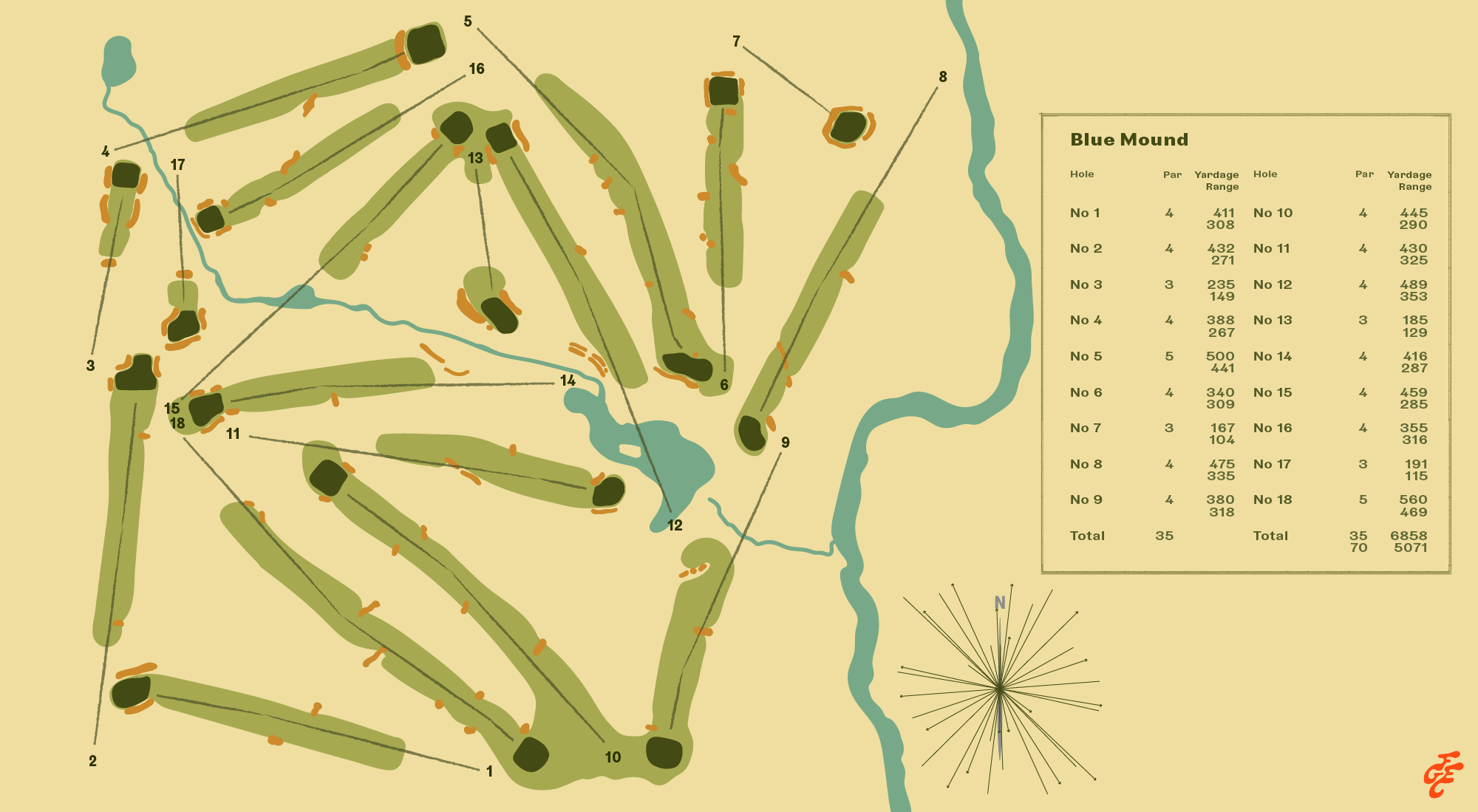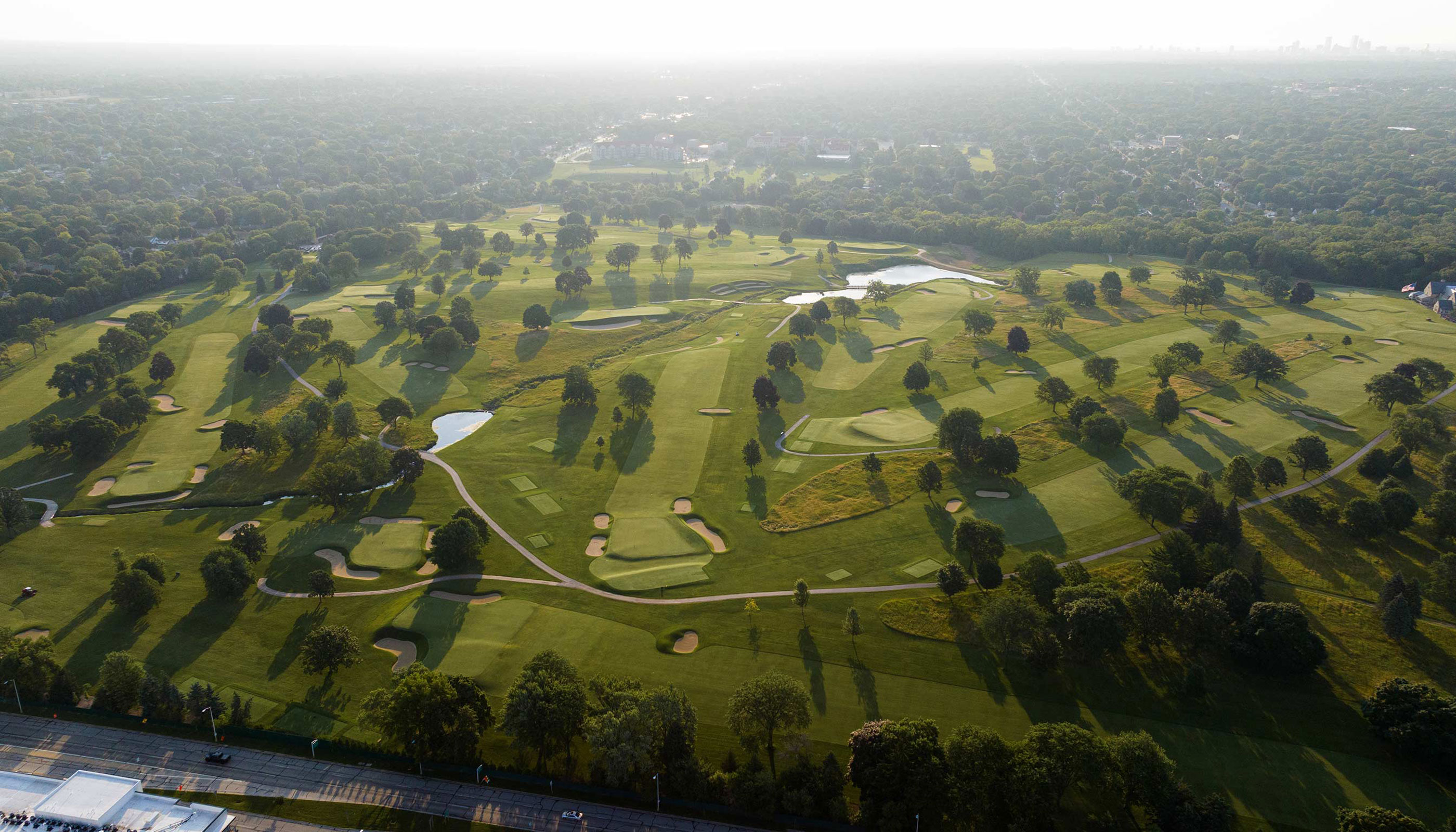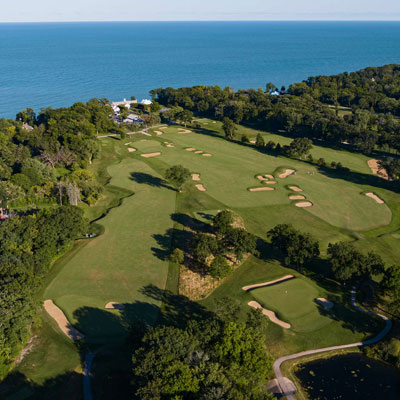Blue Mound Golf & Country Club
Some of Seth Raynor's boldest slopes are found in the Milwaukee suburbs

Wauwatosa, Wisconsin, USA
Seth Raynor (original design, 1926), Bruce Hepner (restoration, 1999-2024)
Private
Superintendent Series: Alex Beson-Crone on Blue Mound and Seth Raynor
Seth Raynor never shied away from bold. A visit to any of his golf courses will confirm that in one way or another. But when it comes to his green complexes, you’d be hard-pressed to find a set more dramatic than Blue Mound Golf & Country Club. The first club in the state of Wisconsin to host a major championship (1933 PGA Championship), the course is a stunning piece of golf course architecture.
A few miles west of downtown Milwaukee, Blue Mound finds itself tucked in the back of a neighborhood and shopping center. The understated club has been around for more than a century and originally opened in what is referred to as the Golden Age of golf course architecture. Like Raynor’s work at Chicago Golf Club, Blue Mound occupies a very flat property with little elevation change. The only holes with much vertical variation are Nos. 7 and 8, a short par 3 that dives down a hill in the property’s northeast corner, and a par 4 that climbs back up said hill at a diagonal. Otherwise, you could very easily look across Blue Mound’s property and see nearly every hole.
To overcome the lack of intrigue in the makeup of the land, Raynor went big with his template hole designs. Really big. From the Double Plateau second hole to the Road fifth hole to the Punchbowl eighth hole, golfers will find some of the most prominent slopes of any Raynor design, especially when compared to the land. The Double Plateau is an especially stark example as its back-right and front-left tiers sit way above the flat front-right section.
While Blue Mound is a tremendous experience in the modern day, it took some work in recent years to get it up to snuff. Bruce Hepner has worked with the club for more than 20 years to bring back much of the Raynor charm that was lost over time. Current superintendent Alex Beson-Crone and predecessor Tim Venes deserve a lot of credit for helping to not only implement Hepner’s changes but also oversee tremendous improvements on their own accord. A recent holistic bunker renovation, along with green and fairway expansions, has the course as good as ever.
Take Note…
Raynorman. Left of the first tee at Blue Mound you will find a bronze statue of Seth Raynor, a reminder of the architect who built the magical experience in front of you.
One way. When visiting Blue Mound, keep your eyes peeled for the entry off North Avenue and don’t be surprised if you need to make a U-turn. The entry is located between two homes and is only accessible by traveling westbound.
Raynor-Banks? In the club's archives is the 1924 Seth Raynor plan of the course, along with his hole-by-hole description of each golf hole. Another set of hand-drawn hole plans by Charles Banks, dated 1927, was discovered and shows recommendations for new bunkers. While the original course was built to the Raynor plans, a 1927 aerial shows that not all of his bunkers were added to the course. Banks was then hired in the fall of 1927 to consult with the club on completing Raynor’s bunkering plan and making necessary improvements to the course. What all this means is that the routing and design were laid out by Raynor, and the bunkering plan was slightly altered and enhanced by Banks in 1927. Be sure to check out the Banks drawing in the Raynor Room in the clubhouse.
{{blue-mound-about-gallery}}
Favorite Hole
No. 8, par 4, 475 yards, “Punchbowl”
A hole so fun to play I’d be wrong not to pick it as my favorite.
Modeled after the 12th at Chicago Golf Club, the eighth at Blue Mound is essentially a mirror image of the epic punchbowl template in Wheaton. The land tilts from right to left versus left to right, and the shape of the green is also flipped, funneling balls from front right to back left. Both greens have similar contouring with the lowest section in the back corner and two distinct internal rails that separate the green into two halves while also aiding surface drainage.
What makes Blue Mound’s punchbowl more exciting than most is the way that it sits into the land. Playing 30 feet uphill and over 470 yards from the back tee, this hole demands well-struck golf shots. The front of the green sits up at the crest of the hill, and then the contours slope down and away, creating a massive bowl with tall perimeter rims. This means your long iron approach is like shooting a deep three-pointer, you’re either going to make it or miss it. Additionally, with the way the bowl edges are maintained, there are often two, three, or even four different routes for you to play a putt or chip to the hole. While many punchbowls often just save bad shots from getting worse, Blue Mound’s extenuates good shots and allows for maximum creativity, making it one of the best versions of the template.
{{blue-mound-favorite-hole-gallery}}
Favorite Hole
No. 8, par 4. 475 yards, “Punchbowl”
A hole so fun to play I’d be wrong not to pick it as my favorite.
Modeled after the 12th at Chicago Golf Club, the eighth at Blue Mound is essentially a mirror image of the epic punchbowl template in Wheaton. The land tilts from right to left versus left to right, and the shape of the green is also flipped, funneling balls from front right to back left. Both greens have similar contouring with the lowest section in the back corner and two distinct internal rails that separate the green into two halves while also aiding surface drainage.
What makes Blue Mound’s punchbowl more exciting than most is the way that it sits into the land. Playing 30 feet uphill and over 470 yards from the back tee, this hole demands well-struck golf shots. The front of the green sits up at the crest of the hill, and then the contours slope down and away, creating a massive bowl with tall perimeter rims. This means your long iron approach is like shooting a deep three-pointer, you’re either going to make it or miss it. Additionally, with the way the bowl edges are maintained, there are often two, three, or even four different routes for you to play a putt or chip to the hole. While many punchbowls often just save bad shots from getting worse, Blue Mound’s extenuates good shots and allows for maximum creativity, making it one of the best versions of the template.
{{blue-mound-favorite-hole-gallery}}
Overall Thoughts
Today, “restorations” typically consist of $20+ million, holistic overhauls of the course features, and references to a few old photos for inspiration. It’s rare to encounter a club that slowly but surely reclaims its classical golf course without strapping it to the surgical table and cutting it open. What I refer to as a true restoration – where overgrowth is peeled back and lost features are thoughtfully reintroduced – just doesn’t happen in the 21st century because many classical golf courses have evolved greatly over time and no longer possess the original features. Blue Mound Golf and Country Club is that rare case where 18 original greens from 1926 remain, and the original plans for the course still exist in great detail. This means the course has a blueprint for exactly how it was laid out and built, allowing it to be gently massaged back towards its original form with careful consideration. Bruce Hepner and Renaissance Golf Design have done just that, and after 25 years of continuous work, Blue Mound has seemingly reached its peak potential.
Before the turn of the century, Blue Mound was in a unique position where it had an original Seth Raynor golf course essentially sitting under a forest of trees and a shrunken shell of its 1920s self. That’s when the club made the brilliant decision to hire a thoughtful team to slowly reclaim the historic golf course that was lying there on the ground. The most transformative change has been the removal of thousands of trees that encroached on the playing corridors, leading to degraded turf health. This has created beautiful long vistas across the site and allowed current superintendent Alex Beson-Crone and his crew to present a firm and fast golf course. When you are able to marry these splendid playing conditions with historic Seth Raynor greens, the sky’s the limit.
{{blue-mound-google-earth-gallery}}
The charm and value of 100-year-old greens cannot be overstated. “They don’t make them like this anymore” couldn’t be more true in regards to putting surfaces that have slowly matured and grown more intricate over time. It’s safe to say that modern construction equipment is to blame for the smooth, continuous sloping contours seen on newly built greens. Blue Mound, on the other hand, has greens that have settled into the landscape and evolved over time, creating micro movements across the surface. Pair this with bentgrass that has grown symbiotically with the soil beneath it and the climate above it and you have something truly special.
Simply put, Blue Mound has one of the best sets of greens in the world. Where the land lacks in dramatic elevation changes, the greens infuse interest into every hole. Take the second hole, for example. Despite being one of the flattest pieces of land on the property, the audacious Double Plateau green makes it one of the most exciting to play during the round. In addition, the various pin positions change the strategy of the hole and how you can attack certain pins. There are likely 15 or more greens that I could analyze and extrapolate how they impact each hole and how it plays, but broadly speaking, it’s the variety of internal contouring and harmonious connection to the surrounding landscape that makes each putting surface so special. From broad heaving contours to subtle fall away sections, you’ll find everything and more at Blue Mound, and the recent greens expansion has only made them better.
As for some standouts, I’d be remiss not to call out the mind-boggling 10th green, which is sort of like a modified Double Plateau green with a “pizza slice” back portion and loads of intriguing movements. On the other hand, the ninth uses a singular central mound to create interest, similar to the third with its central ridge dividing the Biarritz green into a left and right portion. The fourth boasts some rippling waves and the 15th utilizes a bowl, back tier, and front trough, making it one of the most unique I’ve seen on a Raynor design. Another favorite is the sixth, which features a vexing Maiden-style green that tempts and tortures.
{{blue-mound-greens-gallery}}
While a great set of greens can certainly carry a course into honorable territory, it takes a little more than just cool greens to have a truly noteworthy golf course. Like Chicago Golf Club, Blue Mound’s routing maximizes the land that’s offered. The opening five holes play around the flat perimeter land before dipping down towards the river and through the central valley on holes seven through nine. Players then dance through the interior valley at the start of the back nine, which yields some of the more heaving landforms on the site. The 12th is a particularly fine golf hole that plays from the low point in the valley up to a gentle hog’s back fairway. Similarly, the 14th plays out from the valley with a blind tee shot.
Blue Mound certainly doesn’t win any prizes for its land but the way that the design moves around it and takes advantage of even the slightest land movements is masterful. This is perhaps what I admire most about Raynor’s design and his ability to create captivating holes no matter the land quality. Now that many ill-informed tree plantings have been rectified you can gain more appreciation for the subtleties of the landscape and how the holes are laid across it.
In terms of restoration execution, Blue Mound is the gold standard. Greens have been pushed out to the edge of their pads and fairways expanded to the bunker edges with such thoughtful agronomic intention that you’d never know the recent work was done. Furthermore, every bunker was rebuilt in the classic Raynor style but appears to still be their 100-year-old selves. The best part of all of this is that it likely cost dramatically less than what it could have due to patience and quality stewardship. Creating a long-term plan and slowly chipping away at the sculpture one hammer swing at a time has allowed the course to maintain its old-school aura while still keeping up with modern needs. Now the statue is revealed and it looks like Michelangelo’s David—bold, intimidating, and beautiful.
2 Eggs
The long-term work from Bruce Hepner and continual strides in agronomic enhancement from Alex Beson-Crone make Blue Mound one of the finest classic courses in the Midwest. Eclectic greens, exquisite presentation, and a design that maximizes its potential is the path to two eggs. I hope the club’s approach to restoration invites other classic golf courses to tackle their renovation work with careful consideration.
Course Tour

{{blue-mound-course-tour-gallery-01}}
The About and Take Note sections of this profile were written by Will Knights. The rest was written by Matt Rouches.
Additional Content
Superintendent Series: Alex Beson-Crone on Blue Mound and Seth Raynor (Fried Egg Golf Podcast)
Leave a comment or start a discussion
Get full access to exclusive benefits from Fried Egg Golf
- Member-only content
- Community discussions forums
- Member-only experiences and early access to events








.jpeg)



Leave a comment or start a discussion
Lorem ipsum dolor sit amet, consectetur adipiscing elit. Suspendisse varius enim in eros elementum tristique. Duis cursus, mi quis viverra ornare, eros dolor interdum nulla, ut commodo diam libero vitae erat. Aenean faucibus nibh et justo cursus id rutrum lorem imperdiet. Nunc ut sem vitae risus tristique posuere. uis cursus, mi quis viverra ornare, eros dolor interdum nulla, ut commodo diam libero vitae erat. Aenean faucibus nibh et justo cursus id rutrum lorem imperdiet. Nunc ut sem vitae risus tristique posuere.